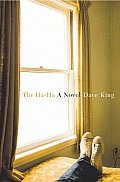
I'm grateful I've lived to see
Lynda Barry sing Emily Dickinson's poem, "
The Loneliness One Dare Not Sound," a stanza here:
I fear me this -- is Loneliness --The Maker of the soulIts Caverns and its CorridorsIlluminate -- or seal --And if you're thinking Yellow Rose of Texas, you're way off. She set it to the classic Brazilian tune, Girl From Impanema. It was one of the main "images" I took away from her class,
Writing the Unthinkable, at the Omega Institute upstate. Writing is a lonely business, one that "causes swelling," in Barry's words, and it's something we practice for our own mental health. Publishing, fame, all that stuff is secondary, and in fact a recent development. Writing has gone on for ages, and words do find ears, or not, and maybe that's not the point. She also recited daily Rumi's poem,
The Diver's Clothes Lying Empty on the Beach, which grew in nuance with every recitation. Both Rumi and Dickinson gave work to the world like "seeds," or "spaceships" (Barry's terms), without the problematic goal of publication. And for every Dickinson, she argues, there are thousands we don't know about.
The goal of the class was exploring writing as a form of solitary "play," the kind that nourishes. To bring home the solitude of writing practice, she kept the class totally anonymous, avoiding the primate instinct to establish hierarchy. (She says that monkeys will give up their food for two things: pictures of monkey genitals, and pictures of the top monkeys.) Feedback on our writing was not allowed. Chitchat in the classroom was not allowed. It was not a social occasion. There were maybe 60 people in the class, and I didn't try to make friends with anyone new. And she gave us, or rented us, her teacher persona as an "image," uniform and all, to take home with us. She wasn't there to be our friend, or even our mentor. She was there to share with us her own working toolbox, to help us explore our own memories, and to offer us new memories to take home.
The focus of the class was what she calls "images," which are detailed slices of memory, the seeds, the resonances, concrete moments in time. We did a lot of list-making, then chose items from lists (or let the items choose us), then written response to her questions to bring the images into clearer focus, then timed freewriting. After the freewriting, we were not to reread our work unless we volunteered to read aloud. Then, while volunteers read, we all doodled spirals and focused on our own drawings, like we were listening to a radio show. This process kept the readings anonymous, and encouraged shy people to read, as if they were reading to themselves. Even she didn't look at the readers: she kneeled before us, looking at our bare feet. After each reading, her only response was a heartfelt "good," with a look in the eye.
Eventually, we moved into fiction, using magazine photos instead of memories as prompts. And after the work we had done with our own lives, the responses to the photos were poignantly vivid and concrete, and evoked real empathy. You could feel it in the room.
This system had several results. One is we not only had access to our own images, but a wealth of images from the anonymous throng. Another is that we were encouraged to turn off our own inner editors, in the absence of specialness and "success." And we were freed to access hidden pockets of our own memories--maybe doodling the spirals helped too--which we can choose to use later, or not.
The toolbox is one I will turn to again. I highly recommend her class for writers at all levels. And for other creative people too, especially introverts, who want to feel awake and alive through this kind of practice. It's a good system for breaking through writer's blocks, and for rediscovering the reason we all do this. It's not for recognition. The thing that moved the class participants was the work itself, the process of contemplation, and the permission to do it, warts and all. The warts were the most beautiful parts.
A few more things I will try to practice going forward. Memorize other people's poems. Recite them over and over to discover what is there. Work in series. Journal in lists of images from the previous day. Grab nouns from the lists and use them as timed writing prompts. Use two timers for freewriting: one to tell me it's time to find the ending, another to say stop. And remember why I'm doing this: it's a daily practice I enjoy. I'm doing this to learn and feel things.
The writing class was one of three classes I attended daily there. Before breakfast, I took an optional yoga class, part flow, part Kundalini breathing practice. Before dinner, I did meditation, led by a Zen practitioner, which was 15 minutes of silent sitting, 15 minutes of slow, present walking, 15 minutes of contemplating specific compassionate ideas, and some chanting. I'm on the fence on chanting, but I did it anyway. It's weird to sing words I don't understand. But I did it, because I didn't want to ruin the experience for the person seated next to me.
The combination of the three daily practices: yoga, writing, and meditation, encouraged me to let go of the judgment I carry. Barry argues that we edit all the time, citing her walk across the Omega campus: "beautiful flower, beautiful flower, hate that birdhouse." I'm paraphrasing, but you get the gist. Lynda Barry's class in particular encouraged me not to judge.
Then, like clockwork, the rest of the hippy-dippy arts week confronted me with the exact thing I LOVE to judge: new age mumbo-jumbo, let's all be free and happy, blah blah blah. It was a nice balance, because Barry's class took us into difficult places--the goal was not happiness there, and anger was allowed. But because of her anti-hierarchy approach, I was gentler with myself, and gentler with these other human beings, many of whom were trying to heal themselves from great physical and psychological suffering.
So, it didn't kill me to chant a little in languages I don't know. Plus, singing feels good. It feels so good that I even took a sampler class for
Sister Alice Martin's Gospel Community, and sang along with everyone else, some of whom were moved to dance. If you know me, you know that hymn-singing is a sensitive area for me. I've left the church, and anything churchy can be traumatic. But I let myself enjoy the happy contagion. I let it be the same as the chanting. It just feels good to let the voice out, and to feel the larger voice around me.
Lots of tears, lots of laughs, lots of contemplation, lots of vegetarian food, and I do feel more open-minded as a result. Now, back to the real world. I hope I can keep some of this with me. I have more photos too, maybe I'll dump them into a new post.


 Here's the trapeze rigging they had in the middle of campus. It was Arts Week, and ordinary citizens were there learning to fly.
Here's the trapeze rigging they had in the middle of campus. It was Arts Week, and ordinary citizens were there learning to fly. On Thursday night, we got to see some of this flying. Plus a mindblowing Mongolian contortionist, and...
On Thursday night, we got to see some of this flying. Plus a mindblowing Mongolian contortionist, and... Puppets!! Courtesy of the concurrent puppet workshop. They joyfully pranced through our Thursday nite vegetarian dinner.
Puppets!! Courtesy of the concurrent puppet workshop. They joyfully pranced through our Thursday nite vegetarian dinner. I loved this one. A big guy in a tie, with a red briefcase that said "Dream Job." God, if only.
I loved this one. A big guy in a tie, with a red briefcase that said "Dream Job." God, if only. On Wednesday, I took a field trip into Woodstock with my friends Marcia and Virginia. We found a house decorated with tile...
On Wednesday, I took a field trip into Woodstock with my friends Marcia and Virginia. We found a house decorated with tile... Marcia, an appreciator and collector of visionary art, was determined to find the maker. No luck.
Marcia, an appreciator and collector of visionary art, was determined to find the maker. No luck. In Woodstock, we happened upon this grave. He did what he could for the master. I was touched.
In Woodstock, we happened upon this grave. He did what he could for the master. I was touched. Then we went to another visionary art site, Opus 40. Stone quarried and arranged onsite, a single sculpture spanning 40 years. My inner sculptor was jealous. It was a lesson in stick-to-it-iveness.
Then we went to another visionary art site, Opus 40. Stone quarried and arranged onsite, a single sculpture spanning 40 years. My inner sculptor was jealous. It was a lesson in stick-to-it-iveness. This greeter at Opus 40 was way more friendly than the human greeter, who chided us for not understanding they were closed. Their signage was inadequate.
This greeter at Opus 40 was way more friendly than the human greeter, who chided us for not understanding they were closed. Their signage was inadequate. A sampling of the veggies we ate daily. These were primarily there for us to contemplate, I think. I never did figure out how they kept the cute rabbits from eating it all. This was where I saw turbaned Kundalini yogis practicing their breathing every morning. Gorgeous swiss chard, cabbage, and sunflowers.
A sampling of the veggies we ate daily. These were primarily there for us to contemplate, I think. I never did figure out how they kept the cute rabbits from eating it all. This was where I saw turbaned Kundalini yogis practicing their breathing every morning. Gorgeous swiss chard, cabbage, and sunflowers. And finally, I did find some kitty love at Omega. I don't know if I find them or they find me. This one was friendly, and a good hunter. Probably an illegal companion for one of the 250 staff members. (Who were beautiful, earnest, and very fun to talk to as well.)
And finally, I did find some kitty love at Omega. I don't know if I find them or they find me. This one was friendly, and a good hunter. Probably an illegal companion for one of the 250 staff members. (Who were beautiful, earnest, and very fun to talk to as well.)

